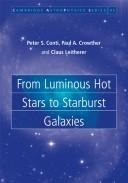| Listing 1 - 7 of 7 |
Sort by
|
Book
ISBN: 1280577177 9786613606884 1441115064 9781441115065 9781441142580 1441142584 9781441130914 1441130918 9781441136077 144113607X Year: 2012 Publisher: London Continuum International Publishing
Abstract | Keywords | Export | Availability | Bookmark
 Loading...
Loading...Choose an application
- Reference Manager
- EndNote
- RefWorks (Direct export to RefWorks)
As a philosophical approach, phenomenology is concerned with structure in how phenomena are experienced. The Phenomenology of Modern Art uses phenomenological insights to explain the significance of style in modern art, most notably in Impressionism, Expressionism, Cezanne and Cubism, Duchampian conceptualism and abstract art. Paul Crowther explores this thematic approachin a new way, addressing specific visual artworks and tendencies in detail and introduces a new methodology- post-analytic phenomenology. It is this more critical, post-analytic orientation that allows the book to utilise some
Art, Modern --- Phenomenology. --- Philosophy, Modern --- Affichistes (Group of artists) --- Fluxus (Group of artists) --- Modernism (Art) --- Schule der Neuen Prächtigkeit (Group of artists) --- Zero (Group of artists) --- Deleuze, Gilles, --- Deleuze, G. --- Delëz, Zhilʹ, --- Dūlūz, Jīl, --- دولوز، جيل --- Delezi, Jier,
Book
ISBN: 9780804798464 9780804795739 9780804798587 0804798583 0804795738 080479846X Year: 2016 Publisher: Stanford, Calif. Stanford University Press
Abstract | Keywords | Export | Availability | Bookmark
 Loading...
Loading...Choose an application
- Reference Manager
- EndNote
- RefWorks (Direct export to RefWorks)
Despite the wonders of the digital world, people still go in record numbers to view drawings and paintings in galleries. Why? What is the magic that pictures work on us? This book provides a provocative explanation, arguing that some pictures have special kinds of beauty and sublimity that offer aesthetic transcendence. They take us imaginatively beyond our finite limits and even invoke a sense of the divine. Such aesthetic transcendence forges a relationship with the ultimate and completes us psychologically. Philosophers and theologians sometimes account for this as an effect of art, but How Pictures Complete Us distinguishes itself by revealing how this experience is embodied in pictorial structures and styles. Through detailed discussions of artworks from the Renaissance through postmodern times, Paul Crowther reappraises the entire scope of beauty and the sublime in the context of both representational and abstract art, offering unexpected insights into familiar phenomena such as ideal beauty, pictorial perspective, and what pictures are in the first place.
Aesthetics --- Painting --- Art, Modern --- Pictures --- Aesthetics, Modern. --- Art and religion. --- Art --- Arts in the church --- Religion and art --- Religion --- Modern aesthetics --- Iconography --- Pictorial representations --- Visual aids --- Modern art --- Nieuwe Ploeg (Group of artists) --- Philosophy. --- Religious aspects
Book
ISBN: 147254580X 1283950677 1441130675 Year: 2013 Publisher: New York : Continuum International Publishing Group,
Abstract | Keywords | Export | Availability | Bookmark
 Loading...
Loading...Choose an application
- Reference Manager
- EndNote
- RefWorks (Direct export to RefWorks)
Contemporary discussions of the image like to emphasize art's societal functions. Few studies come close to answering why pictures and sculptures fascinate and intrigue regardless of any practical functions they might serve. In this original, thought-provoking study, Paul Crowther reveals the intrinsic significance of pictures and sculptures. To address the question of how painting becomes an art, Crowther uses the analytic philosophy of Richard Wollheim as a starting point. But to sufficiently answer the question, he makes an important link to a tradition much more successful in giving voice to the deeper ontology of visual art - existential phenomenology. The result is a work that demonstrates the reciprocal relationship between phenomenology and analytic aesthetics. To expand its ontological scope and solve the problem of expression, analytic aesthetics needs phenomenology; while to develop a sustained, critically balanced, and intellectually available ontology, phenomenology needs the discursive force and lucidity of analytic philosophy. This convincing case for a post-analytic phenomenology of art is an important advancement of contemporary discussions of the philosophy of art
Art --- Phenomenology and art. --- Philosophy.

ISBN: 0804772983 9780804772983 9780804762144 0804762147 Year: 2009 Publisher: Stanford, Calif. Stanford University Press
Abstract | Keywords | Export | Availability | Bookmark
 Loading...
Loading...Choose an application
- Reference Manager
- EndNote
- RefWorks (Direct export to RefWorks)
The book is a comprehensive phenomenological study of meanings that are unique to the major visual art forms.
Aesthetics. --- Art --- Phenomenology and art. --- Philosophy.
Book
ISBN: 1447156005 1447156013 Year: 2013 Publisher: London : Springer London : Imprint: Springer,
Abstract | Keywords | Export | Availability | Bookmark
 Loading...
Loading...Choose an application
- Reference Manager
- EndNote
- RefWorks (Direct export to RefWorks)
Modern businesses depend on data for their very survival, creating a need for sophisticated databases and database technologies to help store, organise and transport their valuable data. This easy-to-read textbook/reference presents a comprehensive introduction to databases, opening with a concise history of databases and of data as an organisational asset. As relational database management systems are no longer the only database solution, the book takes a wider view of database technology, encompassing big data, NoSQL, object and object-relational, and in-memory databases. The text also examines the issues of scalability, availability, performance and security encountered when building and running a database in the real world. Topics and features: Presents review and discussion questions at the end of each chapter, in addition to skill-building, hands-on exercises Introduces the fundamental concepts and technologies in database systems, placing these in an historic context Describes the challenges faced by database professionals Reviews the use of a variety of database types in business environments Discusses areas for further research within this fast-moving domain Suggests a structure for a potential university course in the preface With its learning-by-doing approach, supported by both theoretical and practical examples, this clearly-structured textbook will be of great value to advanced undergraduate and postgraduate students of computer science, software engineering, and information technology. Practising database professionals and application developers will also find the book an ideal reference that addresses today's business needs.
Engineering & Applied Sciences --- Computer Science --- Computer science. --- Software engineering. --- Data structures (Computer science). --- Database management. --- Information storage and retrieval. --- Computer Science. --- Database Management. --- Information Storage and Retrieval. --- Data Structures, Cryptology and Information Theory. --- Software Engineering/Programming and Operating Systems. --- Data base management --- Data services (Database management) --- Database management services --- DBMS (Computer science) --- Generalized data management systems --- Services, Database management --- Systems, Database management --- Systems, Generalized database management --- Electronic data processing --- Information structures (Computer science) --- Structures, Data (Computer science) --- Structures, Information (Computer science) --- File organization (Computer science) --- Abstract data types (Computer science) --- Computer software engineering --- Engineering --- Informatics --- Science --- Information storage and retrieva. --- Data structures (Computer scienc. --- Data Structures and Information Theory. --- Data structures (Computer science) --- Information retrieval. --- Data retrieval --- Data storage --- Discovery, Information --- Information discovery --- Information storage and retrieval --- Retrieval of information --- Documentation --- Information science --- Information storage and retrieval systems --- Information storage and retrieval systems. --- Automatic data storage --- Automatic information retrieval --- Automation in documentation --- Computer-based information systems --- Data processing systems --- Data storage and retrieval systems --- Discovery systems, Information --- Information discovery systems --- Information processing systems --- Information retrieval systems --- Machine data storage and retrieval --- Mechanized information storage and retrieval systems --- Computer systems --- Electronic information resources --- Data libraries --- Digital libraries --- Information organization --- Information retrieval
Book
ISBN: 3030422240 3030422232 Year: 2021 Publisher: Cham, Switzerland : Springer,
Abstract | Keywords | Export | Availability | Bookmark
 Loading...
Loading...Choose an application
- Reference Manager
- EndNote
- RefWorks (Direct export to RefWorks)
Databases. --- Data banks --- Data bases --- Databanks --- Database systems --- Computer files --- Electronic information resources

ISBN: 9780521791342 0521791340 9780511536199 9781107407732 9780511457494 0511457499 0511456182 9780511456183 9780511454455 0511454457 9780511455483 0511455488 1107194814 1281944815 9786611944810 0511453477 0511536194 Year: 2008 Publisher: Cambridge, UK ; New York : Cambridge University Press,
Abstract | Keywords | Export | Availability | Bookmark
 Loading...
Loading...Choose an application
- Reference Manager
- EndNote
- RefWorks (Direct export to RefWorks)
Luminous hot stars represent the extreme upper mass end of normal stellar evolution. Before exploding as supernovae, they live out their lives of a few million years with prodigious outputs of radiation and stellar winds, dramatically affecting both their evolution and environments. A detailed introduction to the topic, this book connects the astrophysics of massive stars with the extremes of galaxy evolution represented by starburst phenomena. A thorough discussion of the physical and wind parameters of massive stars is presented. HII galaxies, their connection to starburst galaxies, and the contribution of starburst phenomena to galaxy evolution through superwinds, are explored. The book concludes with the wider cosmological implications, including Population III stars, Lyman break galaxies and gamma-ray bursts, for each of which massive stars are believed to play a crucial role. This book is ideal for graduate students and researchers in astrophysics interested in luminous hot stars and galaxy evolution.
Starbursts --- Gamma ray bursts --- Stars --- Stellar winds --- Etoiles --- Vents stellaires --- Evolution --- Starbursts. --- Gamma ray bursts. --- Stellar winds. --- Winds, Stellar --- Space plasmas --- Stellar activity --- Stellar evolution --- Compact objects (Astronomy) --- Bursts, Cosmic gamma ray --- Bursts, Gamma ray --- Cosmic gamma ray bursts --- Transients, Gamma ray --- Gamma ray astronomy --- X-ray bursts --- Star bursts --- Starburst galaxies --- Evolution. --- Winds
| Listing 1 - 7 of 7 |
Sort by
|

 Search
Search Feedback
Feedback About UniCat
About UniCat  Help
Help News
News